The name Winnebago is almost synonymous with RVs, and it is a testament to how long and how dominant the brand has been in the recreational vehicle market. The Winnebago Adventurer is one of their flagship gas-powered models, and it boasts features and amenities usually reserved for diesel RVs.
The new Winnebago Adventurer comes with a Ford F53 chassis and a 7.3-liter V8 gas-powered engine. It provides more than enough power to haul its 18,000 pounds of weight in addition to more than 1,400 pounds of cargo.
Read on to find out more about the Winnebago Adventurer, including its specs and a quick review of this RV.
About the Winnebago Adventurer
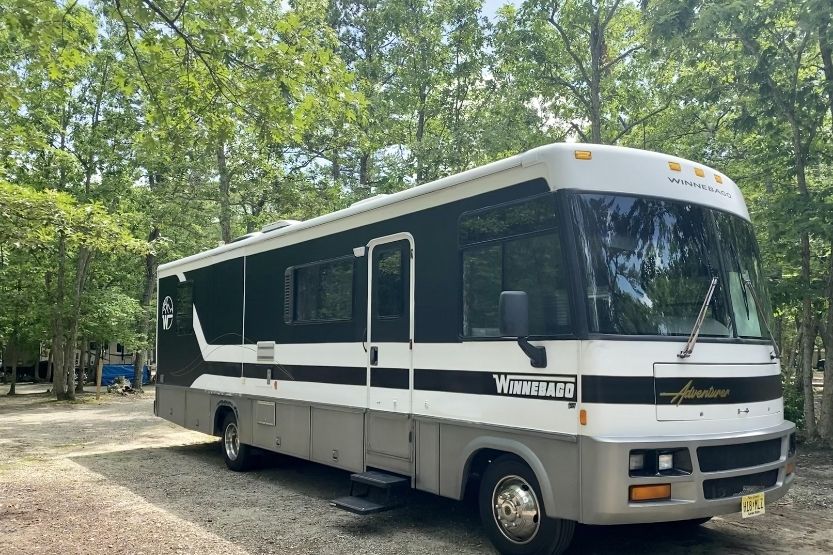
The Winnebago Adventurer is the best-selling, gasoline-powered, Class-A motorhome in the USA. You can choose from six different floor layouts and lengths ranging from 28 feet to 37 feet. It can provide you with all the style, luxury, and necessary amenities you will want and need when traveling.
The Adventurer also allows you to entertain guests indoors and outdoors. It even lets you get a better mobile kitchen than what you can get in most inner-city apartments. Even the smallest Adventurer provides ample living and storage space. It is enough for a weekend trip. You can even take the plunge and live in your motorhome full time.
Adventurer Specs and Features
Engine and Chassis
The Winnebago Adventurer sits on a Ford F53 chassis and is powered by a gasoline 7.3-liter V8 engine. It transmits power to the wheels via a TorqShift 6-speed automatic transmission and HydroBoost System power brakes (4-wheel ABS). This motorhome also comes with automatic leveling jacks with three separate position controls, promoting ease in parking anywhere.
Cab Conveniences
The Adventurer also boasts features that make even hours-long trips a lot more bearable. There is the Versa driver’s seat, which swivels around the steering wheel. This seat has excellent lower back support, including adjustable slide and recline features.
The dashboard has a 7-inch touchscreen head unit. This head unit can serve as your monitor for the rear and side cameras. It’s well suited with Apple CarPlay and Android Auto too.
There is also a passenger side dash workstation with a USB port and 12-volt power supply. This means you can use this part of the motorhome as a mobile office.
Interior
Depending on the model, the Winnebago Adventurer comes with a 39” or 50” HD TV and an omnidirectional antenna. It is also satellite system ready. Some models have an electric fireplace as well.
All models have soft vinyl ceilings, solar and blackout shades, dual-pane windows, vinyl flooring, and a sofa. Some Adventurer models come with Studio Loft-powered loft beds. This creates an extra sleeping space aside from the rear bedroom.
Galley
The kitchen area of the Winnebago Adventurer provides all the amenities that you could wish for. There is a double stainless-steel sink with bamboo covers. It also has a microwave/convection oven, a 3-burner cooktop, a solid countertop with a flip-up extension.
Aside from that, you can have a double-door 10 cubic feet refrigerator/freezer for the three “smaller” models. As for the larger models, expect to get the larger 16 cubic feet refrigerator with an icemaker. All models also come with pantry baskets and cold-water purification systems.
Bath
All Winnebago Adventurers come with basic yet very functional bathrooms. The shower has a flexible showerhead, water pump switches, a textured glass door, and a skylight. There is a fully functional porcelain toilet with a bidet too. Aside from that, you will be getting a medicine and linen cabinet.
Bedroom
If the weather is not conducive to camping outside, you can hunker down on the bedroom area of the Adventurer and plop on top of the queen-sized bed. To maximize the use of space, you can use the frame underneath the bed for storage. There is also a full-sized wardrobe and a chest of drawers for your clothes.
Moreover, the bedroom area comes with a 24” or 32” TV, depending on the model. There is a powered ventilator fan for improved air circulation. Some models even come with a Pet Palace for your fur babies.
Exterior
The exterior of the Winnebago Adventurer is also feature-packed. There are automatic retracting entrance steps, LED porch lights, and large lighted storage compartments. All these features come secured by a Key One locking system.
If you want to entertain guests outside or lounge outside and enjoy the view, a powered patio is an awning with LED lighting. If you got the Tailgate Package, you would be getting a full outdoor kitchen. These include a refrigerator, cabinets, additional LED lights, and a quick connect LP hose for outdoor grills.
HVAC
The front A/C is capable of 15,000 BTUs, while the rear can go up to 13,500 BTUs. All models come with in-floor heating.
Electrical System
All Adventurers come standard with a 5,500-watt Cummins Onan gas generator. It comes equipped with an automatic start system. You can also find 2 deep-cycle batteries in the 27-feet to 30-feet models and 4 batteries in the 35- and 36-footers.
You have the option to have a solar panel charger installed if you want to go green. There are prep kits for wi-fi, cable or satellite TV, and more.
Plumbing
The Winnebago Adventurer has a permanently-mounted LP tank with a pressure gauge, an on-demand water pump, and an onboard water filtration system. It also has a pressurized water hookup with a diverter valve. You can use it when you are hooking the Adventurer to the city water system.
Safety Features
There is a child seat anchor in the forward-facing dinette seat. And you can find a bunch of gas detectors, like LP, carbon monoxide, and smoke. Of course, they come standard with a couple of fire extinguishers. You can also see the brake lamps mounted high so that other drivers can see them easily.
Pros and Cons of the Winnebago Adventurer
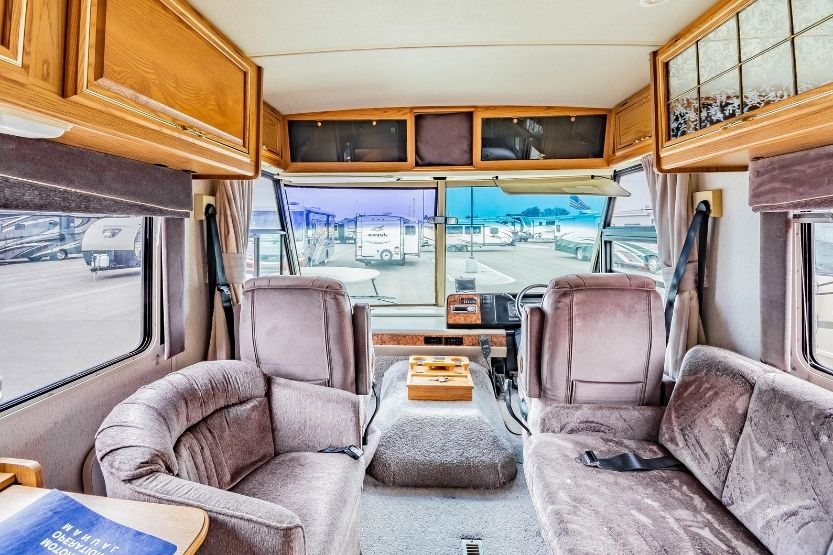
Pros
- You can choose from six different floorplans – The Winnebago Adventurer comes in six different lengths and comes with 1 to 3 slide-outs. You can, therefore, pick the one that fits your needs the most.
- Extend the sleeping and storage capacity using a powered Studio-Loft bed. This optional package will utilize the space above the cab and turn it into an additional sleeping space or storage space. It is a great addition if your kids like to go on road trips with you.
- All models come with a washer/dryer – No need to make frequent stops at laundromats because you can do all your laundry right on board the Winnebago Adventurer. You can now extend your trips without hesitation since you will not run out of clean clothes to wear.
- Comes with a solar panel prep kit – This means that you have the option of having solar panels charge the onboard batteries. Aside from saving gas by not running the generator all the time, you can also do your part in saving the environment by using clean energy.
Cons
- Poor gas mileage – You can only get around 5-8 miles per gallon. It is mainly due to the immense weight of the Adventurer. While the slide-outs provide a lot of living space, the mechanism adds a lot to the vehicle’s overall weight. It means more weight for the engine to power through. Also, although gas engines burn a lot cleaner, they do not have as much torque as diesel engines.
- Very costly – Aside from being quite expensive, a Winnebago Adventurer is costly to maintain. You can expect a brand-new Adventurer to cost around $120k for the base model.
Pros and Cons of Winnebago Rialta RV
History of Winnebago
What most people do not know is that Winnebago started as a civic project. In the late 1950s, the townsfolk of Forest City, Iowa, needed jobs. A local businessman, John K. Hanson, had an idea to boost the job market. He loved going on road trips with his family on their Aljo travel trailer. He then successfully lured the company’s manufacturer to open a factory in Forest City.
Backed by other local businessmen, Modernistic Industries, with just 17 employees, started to manufacture towable travel trailers. Back then, they were 15-foot trailers that cost $895. In 1959, Hanson brought in more investors and bought out the company. This kickstarted a series of innovations to the Aljo trailer, including additional trailer sizes.
Hanson changed the company name to Winnebago Industries. He then turned the struggling company into the powerhouse that it is today. The 1960s was a decade of phenomenal growth for Winnebago.
Deliveries soared from $1 million for the entirety of 1961 to more than $1 million a day by 1968. Winnebago became a trailblazer in the motorhome industry. They even pioneered improvements in quality and manufacturing.
By 1966, Winnebago rolled out their first self-contained motorhome, the F-19. It was the one that set the pace for the entire industry. Winnebago has done so much for the motorhome industry that it became a cultural icon. It is the reason why many people still call RVs “Winnebagos” up to now.
Tips for Maintaining Your Winnebago Adventurer
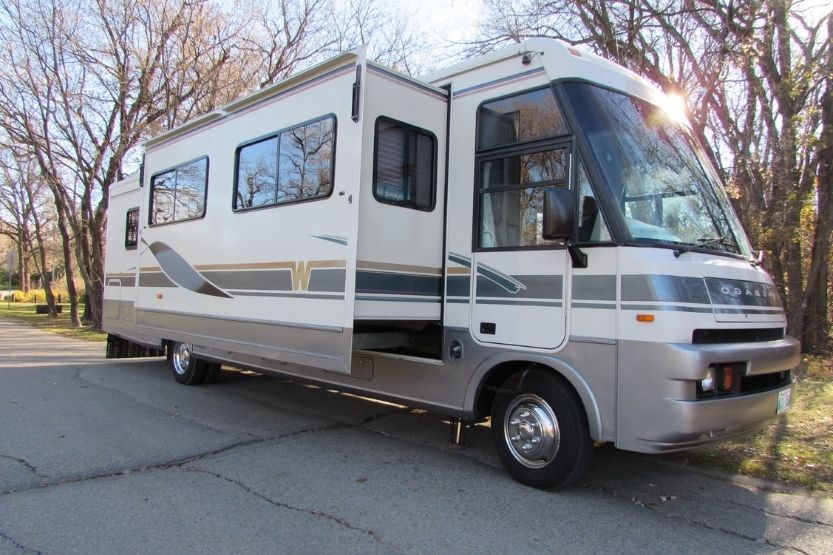
A motorhome, like the Winnebago Adventurer, is a huge investment. You have to take good care of it so it can last for many more years to come. Here’s what you can do:
1. Inspect the Roof Seals and Seams
Repair accordingly. Make it a point to inspect the roof of your motorhome every three months. You still have to do it even if you are not using it. Damaged or opened seams can cause water to leak through. It will initially soak through the roof’s wooden framework and then into the inner panels. The damage will be quite extensive and expensive to repair.
2. Make Sure That the Winnebago’s Lug Nuts Are Tight and the Tires Inflated Properly
Before embarking on your trip, tighten the wheel lug nuts and check the tire pressure. Driving with loose lug nuts is dangerous as it may cause you to lose a wheel while moving at highway speeds. It can also cause a fatal accident.
Overinflated tires run the risk of exploding while on the road. On the other hand, underinflated tires can affect the motorhome’s steering. It can also negatively affect its gas mileage.
3. Check If the Batteries Still Hold a Charge
The worst thing that could happen on your road trip is not happening because the batteries are dead. Batteries tend to last around 3 to 5 years. After that, they will slowly lose their ability to hold a charge. Before going on your trip, have the batteries checked and replace them if necessary.
4. Ensure the Wastewater System Is in Good Condition
Maintaining your Winnebago’s wastewater system includes ensuring that you are using the right chemicals for each system, whether it is gray or black water. Use an adequate amount of fluid to get the system started after flushing. You should then have it flushed on the regular.
5. Check Your Motorhome’s Brakes
Keep in mind that you will be hurtling down the highway in a vehicle that weighs the same as a couple of regular cars. That said, ensure that the brakes are in good condition so they can stop the RV whenever you need to. Check if the brake pads are still thick. If the pads are worn down to the metal, they may cause severe damage to the brake rotor, which can be a costly fix.
6. Clean the Slide-outs and Seals
You need to clean the slide-outs regularly so dirt and debris will not build up on the seals. The reason is that it may cause them to deteriorate quicker. If the slide-out seals are damaged, water can easily leak through and cause extensive damage to the rest of the RV.
Conclusion – Winnebago Adventurer Review
The new Winnebago Adventure now utilizes the Ford F53 chassis. It makes use of a V8 gas engine to power it. This gives the Adventurer more than enough power to carry all its 18,000 pounds, plus more than 1,400 pounds of cargo.
If you are looking for a more compact Class A motorhome that comes with almost the same amount of space and amenities as that of bigger variants, then you need to check out the Winnebago Adventurer.
Related reading:
RV vs Mobile Home – What’s the Difference Between Them?
Motorhome Classes – What Is a Class A, B, and C Motorhome?
Winnebago Models by Year [16 Models]

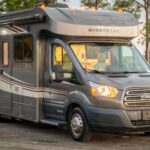
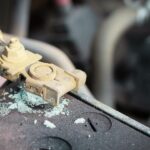
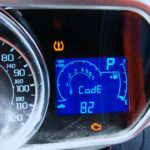
![Check Engine Light On and Off Intermittently [Causes and Fixes] check engine light on and off](https://roadsumo.com/wp-content/uploads/2021/06/check-engine-light-on-and-off-150x150.jpg)
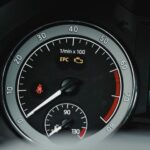

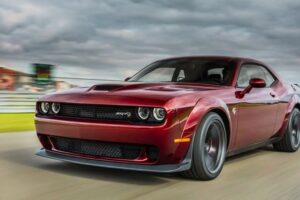
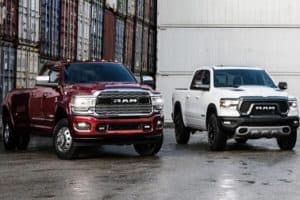
![Read more about the article Bobtail Truck [What Is It? Why Is It Called a Bobtail?]](https://roadsumo.com/wp-content/uploads/2021/06/bobtail-truck-300x200.jpg)